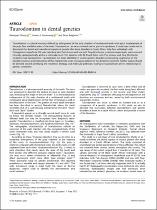| dc.contributor.author | Chetty, Manogari | |
| dc.contributor.author | Roomaney, Imaan A. | |
| dc.contributor.author | Beighton, Peter | |
| dc.date.accessioned | 2022-10-14T11:07:59Z | |
| dc.date.available | 2022-10-14T11:07:59Z | |
| dc.date.issued | 2021 | |
| dc.identifier.citation | Chetty, M. et al. (2021). Taurodontism in dental genetics. BDJ Open, 7, 25. https://doi.org/10.1038/s41405-021-00081-6 | en_US |
| dc.identifier.issn | 2056-807X | |
| dc.identifier.uri | 10.1038/s41405-021-00081-6 | |
| dc.identifier.uri | http://hdl.handle.net/10566/8056 | |
| dc.description.abstract | Taurodontism is a dental anomaly defined by enlargement of the pulp chamber of multirooted teeth with apical displacement of
the pulp floor and bifurcation of the roots. Taurodontism can be an isolated trait or part of a syndrome. A study was conducted to
document the dental and craniofacial aspects of genetic thin bone disorders in South Africa. Sixty-four individuals with
Osteogenesis imperfecta (OI), one individual with Pyle disease and one with Torg-Winchester syndrome respectively, were assessed
clinically, radiographically and at a molecular level. Ten patients with OI XI and those with Pyle disease and Torg-Winchester
syndrome had taurodontism. Taurodontism has been identified in several genetic disorders necessitating cognizance of the
possible existence and implications of this characteristic when managing patients in the dental environment. Further studies should
be directed toward identifying the incidence, etiology, and molecular pathways leading to taurodontism and its relationship to
genetic syndromes. | en_US |
| dc.language.iso | en | en_US |
| dc.publisher | Springer Nature | en_US |
| dc.subject | Taurodontism | en_US |
| dc.subject | Dental genetics | en_US |
| dc.subject | Osteogenesis imperfecta | en_US |
| dc.subject | Pyle disease | en_US |
| dc.subject | South Africa | en_US |
| dc.title | Taurodontism in dental genetics | en_US |
| dc.type | Article | en_US |

